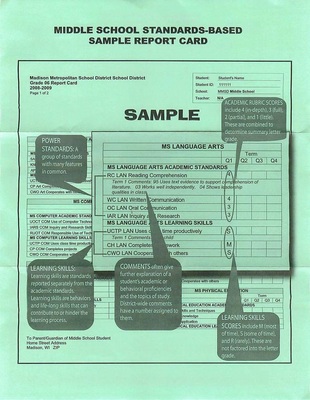Mandated K-12 Testing in Wisconsin: A System in Need of Reform
Mark C. Schug, Ph.D., M. Scott Niederjohn, Ph.D.:
By law public schools in Wisconsin must administer a rigid, comprehensive set of tests. In the fall of every school year students are tested in reading, math, language, science and social studies. Test results from each district and each school are posted on the Internet, passed along to the federal government to comply with No Child Left Behind requirements and are made available to parents. In an era where measurable student performance is essential, it is expected that Wisconsin’s elaborate system of testing will tell us how Wisconsin students are performing. Unfortunately the testing required by Wisconsin state law is not very good.
The purpose of state standards and state-mandated testing is to increase academic achievement. Does Wisconsin’s elaborate system of testing advance this goal? From every quarter the answer is a clear no. That is the consensus of independent, third-party evaluators. Wisconsin’s massive testing program has come under fire from the U.S. Department of Education which said that Wisconsin testing failed to adequately evaluate the content laid out in the state’s own standards. Further, a joint report issued by the independent Fordham Institute and the Northwest Evaluation Association performed a detailed evaluation of testing in every state and ranked Wisconsin 42nd in the nation. The Fordham Institute gave Wisconsin’s testing a grade of “D-minus.”
Perhaps even more troublesome is that many Wisconsin school districts find the testing system inadequate. Over 68% of Wisconsin school districts that responded to a survey said they purchase additional testing to do what the state testing is supposed to do. These districts are well ahead of the state in understanding the importance of timely, rigorous testing.
This report lays out the thirty-year history of testing in Wisconsin and the criticism of the current testing requirement. It is the first of two reports to be issued regarding Wisconsin’s testing program. The second report will show how a new approach to testing will not only meet the standards that parents, teachers and the public expect, but will also allow teachers and policy makers to use testing to actually increase the achievement of Wisconsin’s children.
But perhaps as early as the 2010-’11 school year, things will be different:
- Changes are expected in the state standards for what students are supposed to learn in various grades and subjects. The primary goal of the WKCE is to measure how well students overall are doing in meeting those standards. But Mike Thompson, executive assistant to the state superintendent of public instruction, said new standards for English language arts and math should be ready by the end of this year.
As the policy institute studies note, the existing standards have been criticized in several national studies for being among the weakest in the U.S.- The tests themselves will be altered in keeping with the new standards. Just how is not known, and one key component won’t be clear until perhaps sometime in 2010, the No Child Left Behind Act could be revised. What goes into the new education law will have a big impact on testing in every state.
- The way tests are given will change. There is wide agreement that the wave of the future is to do tests online, which would greatly speed up the process of scoring tests and making the results known. The lag of five months or more now before WKCE scores are released aggravates all involved.
The policy institute studies called for online testing, and the DPI’s Thompson agrees it is coming. Delays have largely been due to practical questions of how to give that many tests on computers in Wisconsin schools and the whole matter of dealing with the data involved.
- Also changing will be the way performance is judged.
Now, Wisconsin and most states measure which category of proficiency each student falls into, based on their answers. Reaching the level labeled “proficient” is the central goal.
Much more on the WKCE here.

